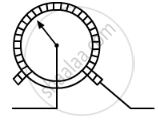Advertisements
Advertisements
Question
Write the relation between resistance and electrical resistivity of the material of a conductor in the shape of a cylinder of length `'l'` and area of cross-section `'A'` . Hence derive the S.I. unit of electrical resistivity.
Solution
`R = (rho l)/A`
δ = Electrical resistivity
A = cross sectional area.
l = length of cylindrical wire.
unit of `rho = (RA)/l` = `(Omegam^2)/m` = `Omega` - m
APPEARS IN
RELATED QUESTIONS
On what factors does the resistance of a conductor depend?
Two conducting wires of the same material and of equal lengths and equal diameters are first connected in series and then parallel in a circuit across the same potential difference. The ratio of heat produced in series and parallel combinations would be:
A copper wire has diameter 0.5 mm and resistivity of 1.6 × 10−8Ω m. What will be the length of this wire to make its resistance 10 Ω? How much does the resistance change if the diameter is doubled?
What is meant by conductors and insulators? Give two examples of conductors and two of insulators.
Which of the following are conductors and which are insulators?
Sulphur, Silver, Copper, Cotton, Aluminium, Air, Nichrome, Graphite, Paper, porcelain, Mercury, Mica, Bakelite, Polythene, Manganin.
Which has less electrical resistance : a thin wire or a thick wire (of the same length and same material)?
How does the resistance of a conductor depend on:
area of cross-section of the conductor?
The figure blow shows a variable resistor in a dimmer switch.

How would you turn the switch to make the lights: (a) brighter, and (b) dimmer? Explain your answer.
Assertion: Conductors allow the current to flow through themselves.
Reason: They have free charge carriers.
How will you infer with the help of an experiment that the same current flows through every part of the circuit containing three resistances in series connected to a battery?
